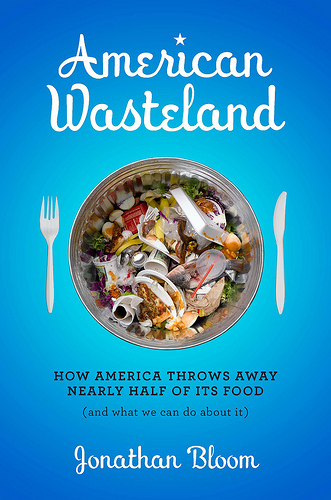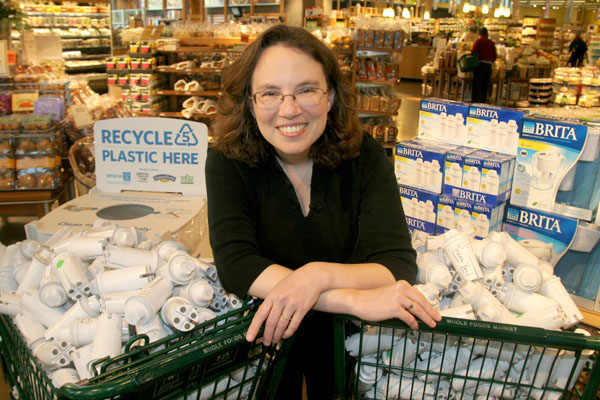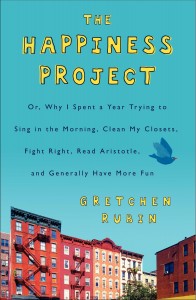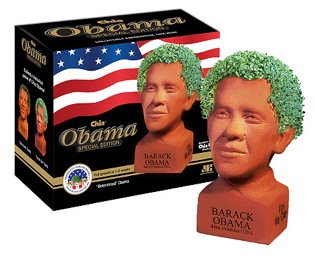
Thank you to everyone who entered to win a copy of Jonathan Bloom’s American Wasteland: How America Throws Away Nearly Half of its Food (and what we can do about it.) The randomly chosen winner was Barb, whose comment will see her becoming quite the expert on issues related to food waste.
In all there were 101 comments, and I’m glad I randomly choose winners, as you guys really had a lot of interesting insight into the issues related to food waste. Here’s just a small sample of some of the comments, and again, thank you to everyone who took the time to enter. Click HERE to read all the comments.
Katy Wolk-Stanley
“Use it up, wear it out, make it do or do without”
Barb:
“I try to only cook what we will eat for that meal. My husband however, cant seem to remember that there are only two of us now. So when he cooks, we have way too much food. He always thinks we’ll eat the leftovers for lunch, but he’s never “in the mood for it”. We also have a problem with our weight so I try not to “push” food we don’t want to eat. It’s getting better, but is still a struggle. I have started composting, so produce that gets forgotten about at least gets composted.”
Rena:
“I grew up with “waste not, want not” values. My parents were very good at buying and preparing food that was not excessive. Leftovers were eaten in the same or different form. We hardly ate out only on special occasions. I now have three school-aged children. I work from home full-time, along with assist my husband and his businesses. Time to shop and cook is hard to do. If we eat out we spend too much and end up bringing food home that doesn’t get eaten. If I shop, I think big with good intentions to create a wonderful dinner. Fresh food spoils fast, frozen food gets lost and forgotten. I am consciously working on changing the way we live so my kids will learn how to value and appreciate money and food.”
Kristen Harrison:
“My mother thinks I’m weird because I love it when my fridge is near empty, it feels so freeing to me. When my fridge is full it stresses me out a little as I hate food waste and I worry we won’t be able to use it all up in time.”
Sandra Jensen:
“My husband has decided he likes to cook. This is great, except for the fact that we are now empty nesters – and he comes from a family that had NINE people at the table. Needless to say we have leftovers coming out of our ears. The freezer is stuffed full and yes I throw away moldy stuff that gets pushed back into the dark reaches of the fridge. If I win this it is going in his Christmas stocking! (after I read it)” 
Raven:
“Food waste and guilt. That’s my relationship to it. I feel tremendously guilty when I waste food. I try so hard not to, but last week I actually managed to put my avocados (sale!) under the loaf of bread and I recovered them too late. I was so sad, because an avocado and tomato sandwich sounded amazing. I lose veggies and fruits that way. I’ll just misplace or forget them and then they go bad. I’m definitely getting better. And I’m pretty good about almost always finishing my cooked leftovers before they go bad. (That’s probably why the fresh stuff gets overlooked.) There are only two of us, no kids yet, so I’m trying to get better at meal planning to prevent this waste. Would LOVE to read this book!”
Missy:
“Although I try not to waste food, it feels so good to now have curbside composting available. All my food waste (yes, including meat bones, eggshells, etc) can go in this container and be turned into rich compost in a high-heat composting facility. I feel truly lucky to have lived in two cities that have offered this fabulous re-use of food. Also, I hope to get chickens soon to minimize even what goes into the compost. I’m interested to read about the issue of food waste on a larger scale, though.”
Patrice Wassman:
“My husband and I made friends with the manager of our local grocery store. We have a trash can out back now, where they throw out all the outdated bread and “rotten” produce. It is ostensibly for our chickens, but it is amazing how much of it we can use. All the bread is fine, usually just outdated that day, or not even! Lots of veggies get thrown away because they have a soft spot. They are salvable. The end of the summer I got so many red, yellow and green peppers it was amazing. They got washed, sliced and frozen. I have also blanched and frozen broccoli, and pre-peeled cut up squash. What we can’t use goes to the chickens and our rapidly filling-up compost bins. It is tragic how much food goes to waste in this country.”
Nupur:
“Food waste makes me mad and sad. I try to minimize mine by making fridge-cleaning meals a couple of times a week, because practically anything can go into a soup, burrito or fried rice to convert leftovers into fresh new meals.”
Jen:
“I wish I could say I don’t have much food waste, but I can’t. I am, as they say, “a big eater”, so I usually clean my plate. It’s the ends of bread and the half jars of mystery food at the back of the fridge that get me.
On the other hand, we often gather at our local artisan bakery to take the extra (and free) loaves off their hands at the end of the day. It’s an interesting mix of people: homeless men, academics, business people, moms, students. All vying for a great deal, and doing their part to reduce food waste. I’m proud to be one of them.”
Like this post? Then please share it with your friends!
Like this:
Like Loading...










